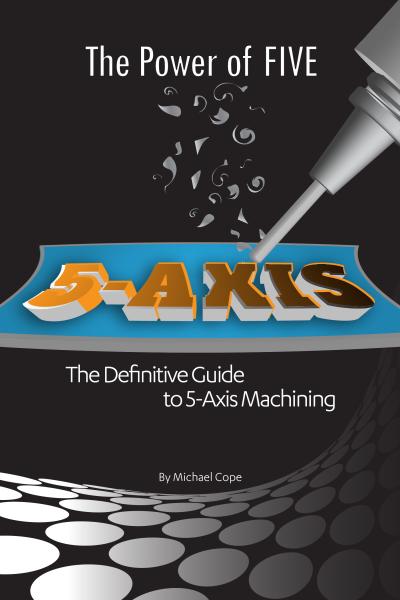
The Power of FIVE: The Definitive Guide to 5-Axis Machining book was officially released this month at an industry conference, Top Shops, in Indianapolis. The author, Michael Cope, is a machinist and works at Hurco as a product technical specialist.
Cope said he wrote the book because the adoption of five-sided machining processes is the most efficient way for job shops to instantly increase productivity and profitability. While there are other books about 5-axis CNC technologies, he saw a need to write a book specifically for machinists.
Cope said: "I’ve always seen myself as a machinist first and wrote this book with the intention of educating machinists and shop owners on the value of 5-axis machining because I truly believe it is the future of our industry and the most efficient way to produce parts. Making the transition to 5-sided machining on a 5-axis CNC machine solves many of the problems so many shops face: finding qualified machinists (the skills gap); excessive setup costs due to inefficiency; and reacting to pressure from customers, both pricing pressure and delivery pressure. To be blunt, 5-axis saves time and money. Since time is money in our industry, 5-axis makes each part more profitable. It offsets the skills gap issue because you can do more with fewer machines, which means you won’t need to find as many skilled employees. The technology makes the process more efficient, which means shops increase productivity because they don’t waste time flipping parts. Making the transition to 5-sided machining on a 5-axis CNC also helps job shops respond effectively to pressure from customers because they can switch from one job to another quickly and efficiently. Basically, you can do more with less if you select the right 5-axis CNC machine."
The idea for the book was realized as Cope was preparing for a conference where he was asked to speak on behalf of Hurco about 5-axis CNC machines and control technologies. Maggie Smith, marketing manager at Hurco, said, “Hurco identified 5-axis as a critical initiative in 2006 because we realized it would help our customers be more profitable. We focused our attention on what we do best: building rigid and reliable CNC machines equipped with the most flexible control that supports both NC and conversational programming, and developing software features that are intuitive and easy to learn. Our software engineers made sure the conversational programming of the 5-axis control makes the transition to 5-sided machining easy. So easy, in fact, that no CAM system is required.”
Contact Details
Related Glossary Terms
- computer numerical control ( CNC)
computer numerical control ( CNC)
Microprocessor-based controller dedicated to a machine tool that permits the creation or modification of parts. Programmed numerical control activates the machine’s servos and spindle drives and controls the various machining operations. See DNC, direct numerical control; NC, numerical control.
- computer-aided manufacturing ( CAM)
computer-aided manufacturing ( CAM)
Use of computers to control machining and manufacturing processes.
- conversational programming
conversational programming
Method for using plain English to produce G-code file without knowing G-code in order to program CNC machines.
- numerical control ( NC)
numerical control ( NC)
Any controlled equipment that allows an operator to program its movement by entering a series of coded numbers and symbols. See CNC, computer numerical control; DNC, direct numerical control.
- sawing machine ( saw)
sawing machine ( saw)
Machine designed to use a serrated-tooth blade to cut metal or other material. Comes in a wide variety of styles but takes one of four basic forms: hacksaw (a simple, rugged machine that uses a reciprocating motion to part metal or other material); cold or circular saw (powers a circular blade that cuts structural materials); bandsaw (runs an endless band; the two basic types are cutoff and contour band machines, which cut intricate contours and shapes); and abrasive cutoff saw (similar in appearance to the cold saw, but uses an abrasive disc that rotates at high speeds rather than a blade with serrated teeth).
